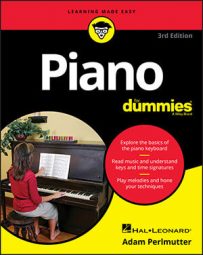You’re learning to play the piano for one simple reason: to play music. Okay, so maybe you’re also learning piano to impress your friends, but after you achieve the first goal, the second naturally just happens.
Unless you’re playing strictly by ear, you need some music to read. Enter the concept of printed music.
Types of printed music
Thanks to five centuries worth of composers, you have a wealth of printed music from which to choose. Generally, you find it in three packages:
Sheet music: Single songs printed on two or more pages, folded or stapled together.
Folios: Collections of various songs, packaged together for a specific marketing reason.
Classical books: Some classical pieces are very long and require an entire little book to hold one piece.
For example, suppose you want to learn the song “Hallelujah,” written by Leonard Cohen, after hearing a recording by Cohen, John Cale, k. d. Lang, Jeff Buckley, or Rufus Wainwright. You can purchase a digital download of the song on sheet music websites, buy the published sheet music of the song from a music store, or get it in a folio of songs from the film Shrek.
Folios are great values. At the time of this writing, sheet music sells for around $4.95 for one song, whereas a folio sells for around $21.95 and may have 10 to 50, or even 100, songs. However, chances are that if you’re looking for a really new song, it will only be available as sheet music.
Arrangements and transcriptions
Printed music, whether sheets or folios, comes in many different formats called arrangements. Arrangements allow the publisher to release the song for several skill levels and for various keyboard instruments. It’s the same song, but the publisher has arranged the notes and chords to suit your needs.
For example, you may want to play a very easy version of a song on your digital keyboard or an advanced piano solo version on a grand piano. Both formats are available. And, of course, you can also find other arrangements of the same song for different instruments and voices.
After you master a song, it’s fun to try playing other arrangements of it, for instance, 18 different versions of “Yankee Doodle,” ranging from plain vanilla to rock ’n’ roll. Your local sheet music dealer can help you find the arrangement and style you want.
Fake books
A fake book is actually a real book. This is the music industry term for a printed music book or folio that gives you only the melody line, lyrics, and chord symbols of a song.
Compared to a piece of sheet music that has both hands written out and fully harmonized, the fake book merely acts as a road map of the song, allowing you to play the melody, sing the lyrics, and create your own left-hand accompaniment with the noted chords.
Working pianists love fake books because they can take a request, flip to the song (usually printed in its entirety on one single page), and improvise their own version of the song.
It’s even better if a pianist is accompanying a singer because a fake book’s streamlined form makes it easy to transpose (or change keys) a song on the spot to accommodate the singer’s range and repeat the whole song or just a certain section. And that’s why you put the little tip jar on your piano!
Here are some excellent fake book options:
The Classical Fake Book (Hal Leonard)
Fake Book of the World’s Favorite Songs (Hal Leonard)
All the Right Changes, by Dick Hyman (Ekay Music)
The New Real Book Vol. 1–3 (Sher Music)
The Real Little Ultimate Fake Book (Hal Leonard)
Where to buy printed music
Printed music used to be easy to buy at your local music store. Unfortunately, music stores have become few and far between, which is a sad thing for those who fondly recall thumbing through the stacks of sheet music and scores at the neighborhood music store. More and more, people turn to the Internet for an easy way to buy sheet music.
If you’re lucky enough to have a local music store that carries instruments and sheet music, please consider supporting it — it’s an institution to be treasured.
The web is a wonderful resource for just about anything. You can find free sheet music for public domain titles as well as sheet music to purchase online. Simply search the title of a song or a composer’s name along with “sheet music,” and you’ll find what you need with a few clicks of the mouse. You may want to start your search at the following websites:
You can also contact any of the following publishers to request catalogs or browse their offerings online:
Many university libraries offer their collections online, and these collections are a valuable resource for out-of-print and public domain music.

